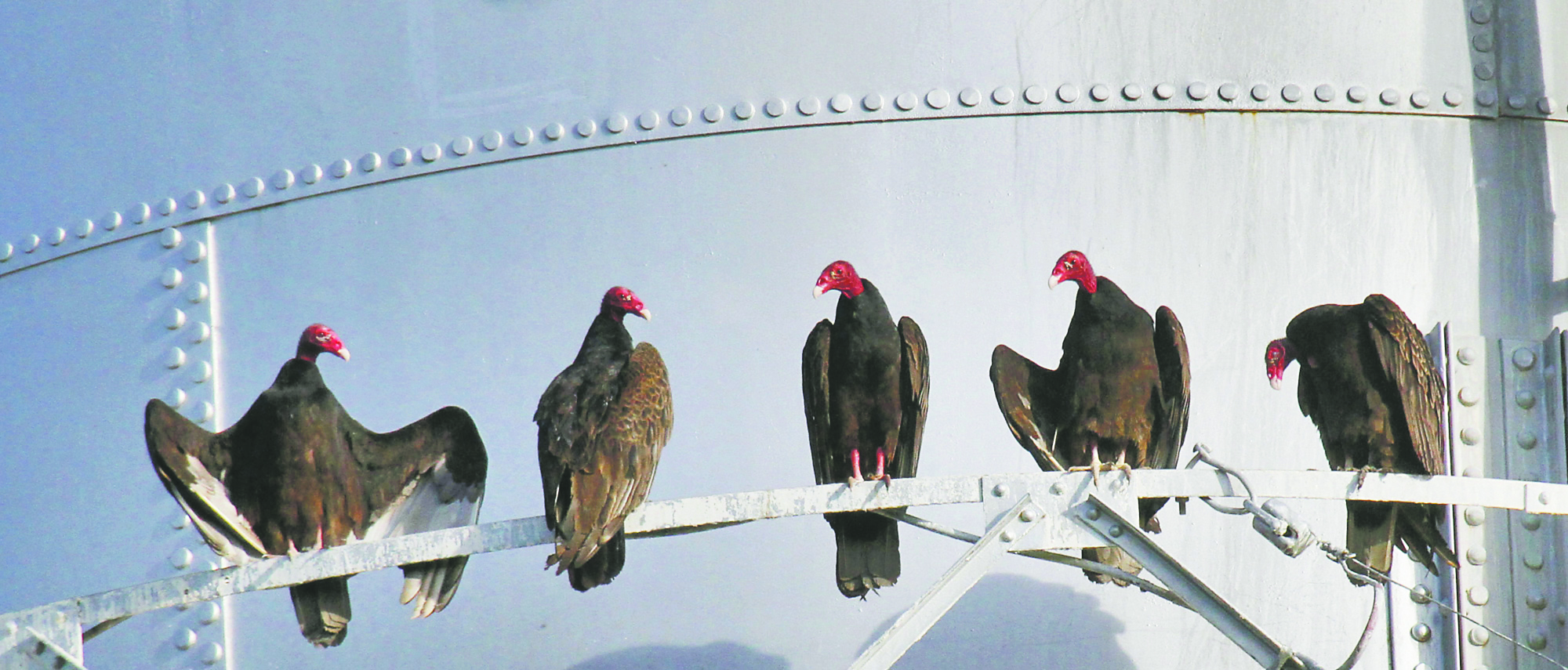Small Kansas town loves its turkey vultures
MARION ? San Juan Capistrano has its dainty, graceful swallows, and Kearney, Neb., its famed migration of majestic sandhill cranes.

Turkey vultures rest on railings around the Marion water tower recently. Up to 200 of the birds have been counted roosting near the town’s high school and downtown.
In Marion, it’s the returning turkey vultures that are largely welcomed each spring.
“Aren’t they something?” Pam Bowers said as she watched three vultures slowly circling high above the city park recently. “Most of us appreciate the chance to watch them. They’re so graceful.”
There is certainly plenty of opportunity for vulture watching in this town of about 2,000 an hour northeast of Wichita.
As many as 200 have been seen roosting near downtown. Many perch on the water tower that rises a few yards from the high school. Others perch amid nearby trees.
Marion may be one of the few places where the species is mostly welcomed.
Vultures have been seen as harbingers of doom for centuries. Black as night, unquestionably ugly and infamous for their diet of things dead and often raunchy, circling vultures have been used by Hollywood to portray pending doom for desert crossers with empty canteens since the days of silent pictures.
Rex Wilson, a vulture fan, said it has been about four years since locals noticed major spring gatherings in Marion. This year it was probably March when he first saw one vulture, then another two the next day, over his house about four blocks from the water tower.
“They must have an amazing internal GPS, the way they keep coming back to that water tower,” Wilson said. “I just have to stop and watch them soar. It’s amazing.”
Big birds
Mark Robbins, a Kansas University ornithologist, said vultures often use community roosting areas, especially when migrating. Marion’s water tower is probably favored by the birds because it’s the highest structure around.
“If you’re up that high, when it warms a bit in the morning, you get these rising thermal currents,” Robbins said. “When the air picks up like that, they can just open their wings and soar. It saves a lot of energy not having to flap to lift that size of body.”
According to the Turkey Vulture Society, a science-based group dedicated to educating the public about the species, adult birds have wingspans of about six feet and weigh about five pounds. In addition to educational programs, the society sponsors vulture art contests and has an Adopt a Vulture program to help pay to rehabilitate injured birds.
Robbins said the birds are well adapted for their job as nature’s sanitation crew. Unlike most birds, turkey vultures have a highly acute sense of smell. Their eyesight is equally good for spotting potential food.
“They’ll eat dead deer by the road or dead skunks. They feed on anything dead,” Robbins said. “If they’re really lucky, they find a rotting cow.”
Robbins describes their oversized beak as “razor sharp.” Of their bald, leathery head and neck, he says “they have to have that because sticking heads with feathers into carcasses would be a real mess.”
A fan of most things feathered, Robbins holds particular respect for the species’ migrational talents. Many of the birds soaring over Marion probably spent the winter in South America.
“There are places in Mexico where you can literally see thousands of turkey vultures flying by, heading to South America,” Robbins said. “It’s quite the thing to watch.”
Popular stopover
Because the species summers as far north as near the Canadian border, Robbins said the turkey vultures Wilson saw weeks ago probably aren’t the same ones sailing over Marion on a recent evening. The town has probably become a resting spot for thousands of vultures during migrations.
The highest annual concentrations are probably a few weeks past, as local vultures have spread across the countryside to nest in places like old barns, the tops of broken trees, ledges and caves.
On a recent Monday evening, about 80 vultures gathered at various locations on the old-fashioned, four-legged water tower and in tall trees along a neighboring creek that passes through town.
Oggie Ogden has no problems with the birds that roost atop the water tower. It’s the ones that roost in the trees of his well-kept, three-acre, heavily wooded yard a block south of the high school that draw his ire.
“They’re a problem because they drop feathers and they drop manure that eventually starts stinking, like chicken poop in a shed,” Ogden said. “We’ve had 60 to 80 in the trees around the place, and that can leave quite the mess.”
His worst day came the morning after an ice storm earlier this year. He had to shoo two vultures from the inside of his garage, and another eight or 10 from a picnic table under his deck. They left tell-tale white stains of their presence after Ogden forced them to leave.
“They were covered in ice and couldn’t do anything but walk and hop around,” he said. “They were able to fly when it warmed up.”
Wilson and Bowers said the birds have worked their way into becoming an appreciated part of Marion’s Chingawassa Days. Usually scheduled around the first weekend in June, it’s a three-day celebration that features everything from bands like the Guess Who and the Nitty Gritty Dirt Band to such family-based activities as a Spam-carving contest and a rock-paper-scissors tournament.
“You’ll be sitting there, supposedly watching a rock and roll band, and you see most people are looking up, watching the (vultures) soaring around,” Bowers said. “It’s hard not to enjoy them. Maybe they’re even bringing us some tourists.”







